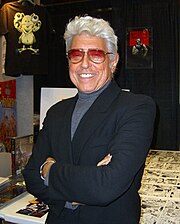
Captain America is a superhero created by Joe Simon and Jack Kirby who appears in American comic books published by Marvel Comics. The character first appeared in Captain America Comics #1, published on December 20, 1940, by Timely Comics, a corporate predecessor to Marvel. Captain America's civilian identity is Steve Rogers, a frail man enhanced to the peak of human physical perfection by an experimental "super-soldier serum" after joining the United States Army to aid the country's efforts in World War II. Equipped with an American flag–inspired costume and a virtually indestructible shield, Captain America and his sidekick Bucky Barnes clashed frequently with the villainous Red Skull and other members of the Axis powers. In the final days of the war, an accident left Captain America frozen in a state of suspended animation until he was revived in modern times. He resumes his exploits as a costumed hero and becomes leader of the superhero team the Avengers, but frequently struggles as a "man out of time" to adjust to the new era.

Jack Kirby was an American comic book artist, widely regarded as one of the medium's major innovators and one of its most prolific and influential creators. He grew up in New York City and learned to draw cartoon figures by tracing characters from comic strips and editorial cartoons. He entered the nascent comics industry in the 1930s, drawing various comics features under different pen names, including Jack Curtiss, before settling on Jack Kirby. In 1940, he and writer-editor Joe Simon created the highly successful superhero character Captain America for Timely Comics, predecessor of Marvel Comics. During the 1940s, Kirby regularly teamed with Simon, creating numerous characters for that company and for National Comics Publications, later to become DC Comics.

The Silver Age of Comic Books was a period of artistic advancement and widespread commercial success in mainstream American comic books, predominantly those featuring the superhero archetype. Following the Golden Age of Comic Books, the Silver Age is considered to cover the period from 1956 to 1970, and was succeeded by the Bronze Age.

James F. Steranko is an American graphic artist, comic book writer/artist, comics historian, magician, publisher and film production illustrator.
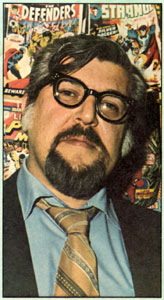
John Buscema was an American comic book artist and one of the mainstays of Marvel Comics during its 1960s and 1970s ascendancy into an industry leader and its subsequent expansion to a major pop-culture conglomerate. His younger brother Sal Buscema is also a comic book artist.
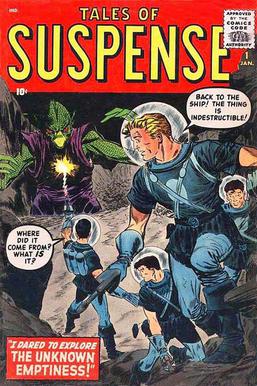
Tales of Suspense is the name of an American comic book anthology series, and two one-shot comics, all published by Marvel Comics. The first, which ran from 1959 to 1968, began as a science-fiction anthology that served as a showcase for such artists as Jack Kirby, Steve Ditko, and Don Heck, then featured superheroes Captain America and Iron Man during the Silver Age of Comic Books before changing its title to Captain America with issue #100. Its sister title was Tales to Astonish. Following the launch of Marvel Legacy in 2017, Tales of Suspense was once again resurrected at issue #100, featuring the Winter Soldier and Hawkeye in a story called "The Red Ledger".
Strange Tales is a Marvel Comics anthology series. The title was revived in different forms on multiple occasions. Doctor Strange and Nick Fury, Agent of S.H.I.E.L.D. made their debuts in Strange Tales. It was a showcase for the science fiction/suspense stories of artists Jack Kirby and Steve Ditko, and for the groundbreaking work of writer-artist Jim Steranko. Two previous, unrelated magazines also bore that title.
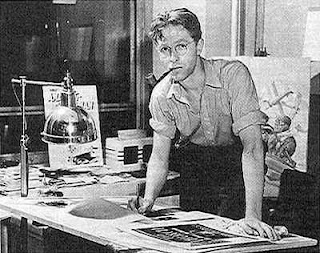
William Blake Everett was an American comic book writer-artist best known for creating Namor the Sub-Mariner as well as co-creating Zombie and Daredevil with writer Stan Lee for Marvel Comics. He was allegedly a descendant of the childless poet William Blake and of Richard Everett, founder of Dedham, Massachusetts.
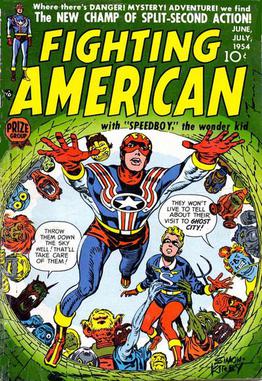
Fighting American is a superhero created in 1954 by the writer-artist team of Joe Simon and Jack Kirby. Published by the Crestwood Publications imprint Prize Comics, it was, contrary to standard industry practices of the time, creator-owned. Harvey Comics published one additional issue in 1966. One final inventoried tale was published in 1989, in a Marvel Comics hardcover collection of all the Fighting American stories.
Young Allies is the name of three superhero teams appearing in American comic books published by Marvel Comics.
Carl Burgos was an American comic book and advertising artist best known for creating the original Human Torch in Marvel Comics #1, during the period historians and fans call the Golden Age of comic books.

Jeffrey Solomon Mace, also known as the Patriot and Captain America, is a superhero appearing in American comic books published by Marvel Comics. The character was created during the 1940s, a period fans and historians call the Golden Age of Comic Books. As the Patriot, he first appeared in Human Torch Comics #4, published by Marvel's 1940s precursor, Timely Comics.
The Alley Award was an American annual series of comic book fan awards, first presented in 1962 for comics published in 1961. Officially organized under the aegis of the Academy of Comic Book Arts and Sciences, the award shared close ties with the fanzine Alter Ego magazine. The Alley is the first known comic book fan award.

Betsy Ross is a character appearing in American comic books published by Marvel Comics. Created by Joe Simon and Jack Kirby, the character first appeared in Captain America Comics #1. Betsy Ross is Captain America's early love interest and supporting character in American comic books published by Marvel Comics during the 1930-1940s period known to historians and collectors as the Golden Age of Comic Books. She then debuted as the superheroine Golden Girl in Captain America Comics #66.

La Contessa Valentina Allegra de la Fontaine is a fictional character appearing in American comic books published by Marvel Comics. Created by writer-artist Jim Steranko, she first appeared in the "Nick Fury, Agent of S.H.I.E.L.D." feature in Strange Tales #159.
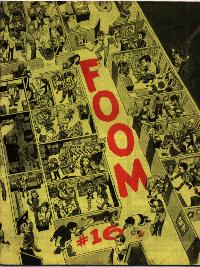
FOOM was Marvel Comics' self-produced fan magazine of the mid-1970s, following the canceled Marvelmania and preceding Marvel Age. Running 22 quarterly issues, it was initially designed and edited by comic book writer-artist Jim Steranko.

Captain America is the name of several comic book titles featuring the character Captain America and published by Marvel Comics, beginning with the original Captain America comic book series which debuted in 1968.

James Buchanan "Bucky" Barnes is a character appearing in American comic books published by Marvel Comics. Originally introduced as a sidekick to Captain America, the character was created by Joe Simon and Jack Kirby and first appeared in Captain America Comics #1. Barnes' original costume and the Bucky nickname have been used by other heroes in the Marvel Universe over the years.

Nick Fury, Agent of S.H.I.E.L.D. is the title of several American comic book series published by Marvel Comics focusing on the various adventures of the character Nick Fury while working for the fictional organization S.H.I.E.L.D.

"Nick Fury, Agent of S.H.I.E.L.D." is a feature that was in the comics anthology Strange Tales which began in 1965 and lasted until 1968. It introduced the fictional spy agency S.H.I.E.L.D. into the Marvel Comics world and reintroduced the character of Nick Fury as an older character from his concurrently-running series Sgt. Fury and his Howling Commandos, which was a series set during World War II. The feature replaced the previously running Human Torch feature in the book and ran alongside the Doctor Strange feature. After the feature ended, a comic book series was published which has had several volumes as well as a comic strip. The feature was originally created by the duo of Stan Lee and Jack Kirby who also created the original Sgt. Fury series but it was later taken over by artist and writer Jim Steranko. The feature was often censored by the Comics Code Authority due to Jim Steranko's provocative art; this art helped change the landscape of comics which Steranko continued with in the 1968 ongoing series. Much of Nick Fury's supporting cast originated in the feature and many of the devices used by these characters were often used in other comics published by Marvel.


